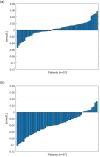Mathematical modelling of post-filter ionized calcium during citrate anticoagulated continuous renal replacement therapy
- PMID: 33630962
- PMCID: PMC7906315
- DOI: 10.1371/journal.pone.0247477
Mathematical modelling of post-filter ionized calcium during citrate anticoagulated continuous renal replacement therapy
Abstract
Background/aims: Post-filter ionized calcium (iCa) measured on a blood gas analyzer (BGA) during regional citrate anticoagulated continuous renal replacement therapy (CRRT) are needed to control the regime. This increases the workload and requires attention including interpretation of blood analyses. Two algorithms were developed to calculate the post-filter iCa instead. The first algorithm used measured systemic total calcium and the second used a selected set of values from an initial blood gas sample as input.
Methods: Calculated post-filter iCa values were compared to real blood gas analyses. 57 patients treated at the intensive care unit at Skåne University Hospital in Lund during 2010-2017 were included after applying inclusion and exclusion criteria. Clinical and machine parameters were collected from the electronic medical records. Non-quality checked data contained 1240 measurements and quality checked data contained 1034 measurements.
Results: The first algorithm using measured systemic total calcium resulted in slightly better precision and trueness with an average difference between the predicted and measured post-filter iCa concentration of 0.0185±0.0453 mmol/L for quality checked data, p<0.001. Neither algorithm could detect all instances requiring intervention.
Conclusion: The algorithms were able to estimate in range postfilter iCa values with great trueness and precision. However, they had some difficulties to estimate out-of-range postfilter iCa values. More work is needed to improve the algorithms especially in their citrate-modelling.
Conflict of interest statement
Forsal, Nilsson and Wieslander are employed by Baxter Healthcare Corporation. Bodelsson and Broman are employed by Skåne University Hospital. Baxter Healthcare Corporation provided salaries for the authors IF, AN, AW, but did not have any additional role in the study design, data collection and analysis or decision to publish. No further competing interests exist. No commercial affiliation will alter our adherence to PLOS ONE policies on sharing data and materials.
Figures




Similar articles
-
The possibility of using effluent ionized calcium to assess regional citrate anticoagulation in continuous renal replacement therapy.Int J Artif Organs. 2020 Jun;43(6):379-384. doi: 10.1177/0391398819894595. Epub 2019 Dec 18. Int J Artif Organs. 2020. PMID: 31849251
-
Discrepant post filter ionized calcium concentrations by common blood gas analyzers in CRRT using regional citrate anticoagulation.Crit Care. 2015 Sep 8;19(1):321. doi: 10.1186/s13054-015-1027-1. Crit Care. 2015. PMID: 26353802 Free PMC article.
-
Impact of increasing post-filter ionized calcium target on filter lifespan in renal replacement therapy with regional citrate anticoagulation: A before-and-after study.J Crit Care. 2023 Dec;78:154364. doi: 10.1016/j.jcrc.2023.154364. Epub 2023 Jun 26. J Crit Care. 2023. PMID: 37379797
-
Safety and efficacy of regional citrate anticoagulation for continuous renal replacement therapy in liver failure patients: a systematic review and meta-analysis.Crit Care. 2019 Jan 24;23(1):22. doi: 10.1186/s13054-019-2317-9. Crit Care. 2019. PMID: 30678706 Free PMC article.
-
Energy expenditure and caloric targets during continuous renal replacement therapy under regional citrate anticoagulation. A viewpoint.Clin Nutr. 2020 Feb;39(2):353-357. doi: 10.1016/j.clnu.2019.02.034. Epub 2019 Feb 23. Clin Nutr. 2020. PMID: 30852030 Review.
Cited by
-
Citrate regional anticoagulation of 500 ml/min of extracorporeal blood flow: an experimental study.Intensive Care Med Exp. 2025 Jun 24;13(1):64. doi: 10.1186/s40635-025-00771-7. Intensive Care Med Exp. 2025. PMID: 40553241 Free PMC article.
References
MeSH terms
Substances
LinkOut - more resources
Full Text Sources
Other Literature Sources
Miscellaneous

